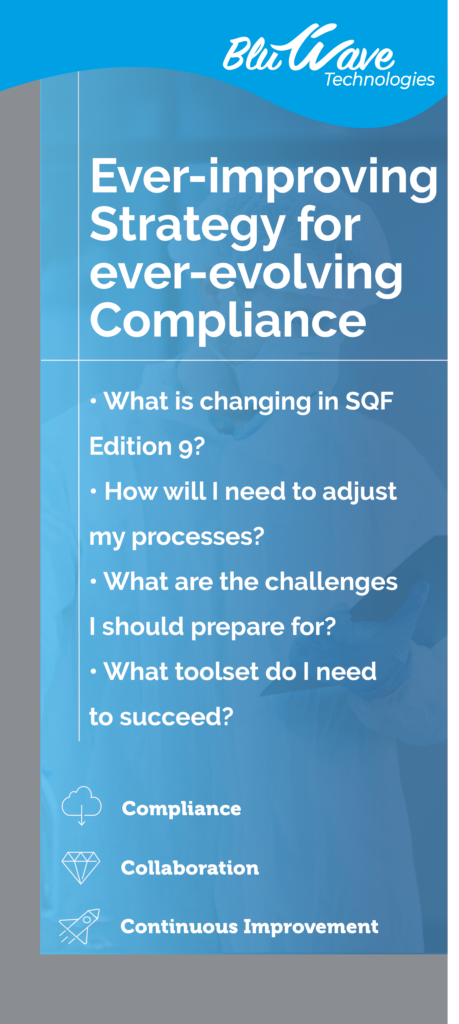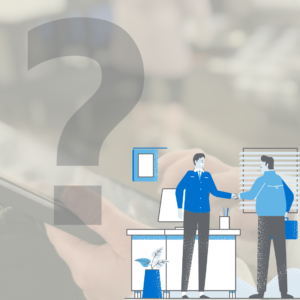SQF Edition 9: Changes & Challenges
SQF Edition 9: Changes & Challenges (3-4 minute read)
With time dwindling down and resources that may be tied up in other projects, we’re here to simply lay out several key, systematic changes that will affect your plant, your processes, technologies, and overall approach to food safety systems due to the new SQF Edition 9 release.
SQF Edition 9 brings new structural and technical changes that many companies will be able to implement as continuous improvement initiatives. In this blog we offer insights into the new code to help release the pressure of new-coming standards or procedures your business will be required to comply with. Here are some of the pressing questions you may have:
- What is changing in SQF Edition 9?
- How will I need to adjust my processes?
- What are the challenges I should prepare for?
- What toolset do I need in order to succeed?
What seems to be ever-evolving compliance standards are hard to keep up with and even harder to find ever-evolving strategies to meet and exceed these standards. Here are the areas of SQF Edition 9 impacting technology that we will briefly cover:
- Part B: The SQF Food Safety Code: Food Manufacturing – System Elements
- Section 2.1 – Management Commitment
- Section 2.2 – Document Control and Records
- Section 2.4 – Food Safety System
- Section 2.5 – SQF System Verification
- Section 2.6 – Product Traceability and Crisis Management
Section 2.1 – Management Commitment:
Highlighting Food Safety Culture is a significant change in the SQF Edition 9 release. It outlines a commitment of a total food safety culture that includes the support of senior leadership, accountability, responsibility, empowerment, and of course, documentation. Section 2.1 also includes requirements to establish food safety objectives, track performance measures, and perform regular performance reviews by site management.
For compliance, it’s important to identify 5-10 Key Performance Indicators (KPIs) for your food safety system, define the goals and measure performance on a routine cadence.
Examples of Objectives:
- Recall and foodborne illness outbreak avoidance
- External and internal audit results,
- Customer complaints
- GMP (Good Manufacturing Practices) compliance
- Microbiological specification compliance
- Regulatory compliance
- Training % completion
- Employee turnover
- Absenteeism rates
- Number of employee suggestions
BluWave Dashboards are the perfect way to measure and track these results.
Section 2.2 – Document Control and Records:
Records are a mandatory part of the SQF Standards. You must generate legible records of monitoring activities for inspection, analyses, and other essential activities. These records must also be stored correctly in a safe, protected, and efficiently retrievable manner to prevent loss, damage, or unauthorized access of information at all times.
Section 2.4 – Food Safety System
The food safety team must determine, document, and control all significant hazards. This requires food plants to be tracking and trending key CCP or Preventive Controls data and for assigned personnel to take part in monitoring, documenting, and the verifying of records. Section 2.4 also now outlines the requirement to keep traceable and verifiable records of non-conforming products or materials as well as product rework.
Section 2.5 – SQF System Verification
The documentation of verification activities for GMPs, critical control points, food safety controls, and legality of products will be an enhanced requirement under SQF Edition 9. During internal audits and inspections, the food safety team must record evidence during findings, document deficiencies, and record any and all actions taken during inspection for corrective and preventive measures.
Section 2.6 – Product Traceability and Crisis Management
Clearer identification and record-keeping of raw materials, ingredients, packaging, work-in-progress, process inputs, and finished products during all stages of the manufacturing process are required. Also included in this section now requires product start-up, product changeover, and packaging changeover (including label changes) procedures must be documented to ensure the correctness of product, package, and label and that the changeover is inspected and approved by an authorized person. Methods for tracking label reconciliation must be implemented.
Recommendations of Implementation:
- Download the applicable SQF Code and Checklist available at www.sqfi.com
- Download the SQF Edition 9 Implementation Strategies Whitepaper
- Determine Strategies for Structural and Technical Changes for compliance
- Define your Food Safety Culture system including Objectives and Performance Measures
- Create and source Solutions for Implementation
- Scale and Continuously Improve enhanced Systems/ Processes

Many plants are still navigating what it means to live in a world in which compliance is constantly changing. Consumers are demanding more operations or supply chain data. Operations must continuously improve to stay competitive or even stay in business.
Although these may be pressing issues you face, there is always security in digital strategies that empower your plant and prepare your organization for higher achievement. Companies need to embrace technology solutions to further food safety culture, tracking of key data for food safety and quality and trending data for continuous improvement.
BluWave Technologies offers great tools to digitize records and exceed compliance, provide targeted reports, and track KPI’s for all aspects of the operation in our unique dashboard displays.
We hope that this blog was insightful to several of the systematic changes in SQF Edition 9. If you’d like to learn more about SQF Edition 9 or explore how digital tools can help you transition into the ever-evolving world of compliance, click the link below for more information.
